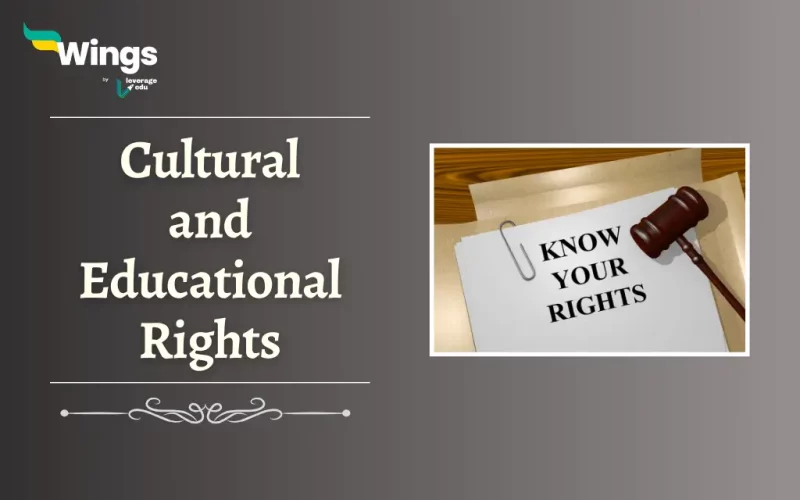In India, Cultural and Educational Rights are Fundamental Rights guaranteed by the Indian Constitution to protect and promote diverse Cultural and Educational forms for its citizens. These Rights primarily fall under Articles 29 and 30 of the Constitution. Additionally, these Rights are significant in India’s diverse and pluralistic society. They protect the interests of different religious and linguistic groups. Moreover, they guarantee the preservation of their distinct culture and education-based institutions. Furthermore, they contribute to promoting unity in diversity and ensuring equal opportunities for all citizens in the realm of education.
Table of Contents
Article 29: Protection of Interests of Minorities
Article 29 protects the interests of Minorities are as follows:
Article 29 (1): Any group of citizens living in India or any part of it, who have a unique language, script, or culture, have the right to protect and preserve their heritage.
Article 29 (2): No citizen can be refused entry to a government-funded educational institution solely because of their religion, race, caste, language, or any combination of these factors.
Interpretation of Article 29
Article 29 of the Constitution of India is titled “Protection of Interests of Minorities.” But interestingly, it does not use the term “minority” within its actual content.
- This was a deliberate choice by the Drafting Committee of the Constituent Assembly. Moreover, it incorporated Cultural and Educational rights in the Constitution of India.
- While the Advisory Committee suggested including the term ‘minority’ in the provision. The Drafting Committee opted for the phrase “sections of citizens” to allow for a broader interpretation.
- They aimed for a wide interpretation, which could even encompass scenarios like considering Maharashtrians in Bengal as a minority if the situation required it.
- In a notable case in Ahmedabad St. Xavier’s College Society v. State of Gujarat (AIR 1974 SC 1389), the Court took a step further. It ruled that majority groups could seek protection under Article 29 despite the term ‘minorities’ being in the provision’s title.
Furthermore, the “Right to Conserve” was granted in Article 29(1) by the Court in the case of Jagdev Singh Sidhanti v. Partap Singh (AIR 1965 SC 183,188). To include the freedom to advocate for the preservation of their language, which essentially extends to protecting their political and regional interests.
Also Read: Right Against Exploitation
Article 30: Right of Minorities to Establish and Administer Educational Institutions
Article 30 (1): All minority communities, whether defined by religion or language, have the right to establish and manage educational institutions according to their choice.
Article 30 (1A): When creating any law that involves the compulsory acquisition of property belonging to an educational institution run by a minority as described in clause (1), the government must ensure that the compensation set by that law does not impede or undermine the rights guaranteed in that clause.
Article 30 (2): The government must not show bias when providing financial support to educational institutions, and it must not discriminate against any educational institution solely because it is managed by a minority, whether based on religion or language.
Interpretation of Article 30
Article 30 of the Indian Constitution specifically addresses the rights of linguistic and religious minorities.
- Unlike Article 29, which uses the term “sections of citizens.” Article 30 explicitly uses the term “minorities” because it exclusively focuses on safeguarding the rights of minorities.
- This distinction highlights the protection of minorities in both Article 29 and Article 30. Even though these are distinct rights, as clarified in the case of Father Proost v. the State of Bihar (AIR 1969 SC 465).
Also Read: Right to Freedom (Article 19-22)
Who are Minorities in India?
To understand these Cultural and Educational Rights in India, it is essential to recognize the concept of ‘minority’ in the Indian context. Interestingly, the term “minorities” has not been explicitly defined. The Motilal Nehru Report from 1928 expressed a strong desire to protect minorities. However, they did not provide a specific definition for the term. Similarly, the Sapru Report in 1945 proposed the establishment of a Minorities Commission. But did not offer a clear definition for ‘minority.’
The U.N. Sub-Commission on Prevention of Discrimination and Protection of Minorities has provided a comprehensive definition of ‘minority.’ According to this definition:
- A ‘minority’ encompasses those non-dominant groups within a population who possess and wish to preserve distinct ethnic, religious, or linguistic traditions or characteristics that notably differ from the majority.
- These minorities should be of a significant size to effectively maintain these traditions or characteristics on their own.
- Additionally, these minorities must demonstrate loyalty to the nation of which they are citizens.
Also Read: What is Representative Democracy?
Furthermore, here are some important judgements related to the Cultural and Educational rights:
- SP Mittal vs. Union of India
- State of Madras vs. Champakam Dorairajan
- State of Bombay vs. Bombay Educational Society
- DAV College, Punjab vs. State of Punjab
Results
#1. What does Article 30 guarantee?
#2. Which Article of the Indian Constitution states that no citizen can be refused entry to a government-funded educational institution based on race, religion, or caste?
#3. Which article/s of Indian Constitution offer cultural and educational rights?
Related Blogs
Lastly, we hope you liked our blog and gained an understanding of Cultural and Educational Rights in India. Moreover, you may even read more blogs and empower yourself with knowledge regarding Civics and Polity!
 One app for all your study abroad needs
One app for all your study abroad needs
















